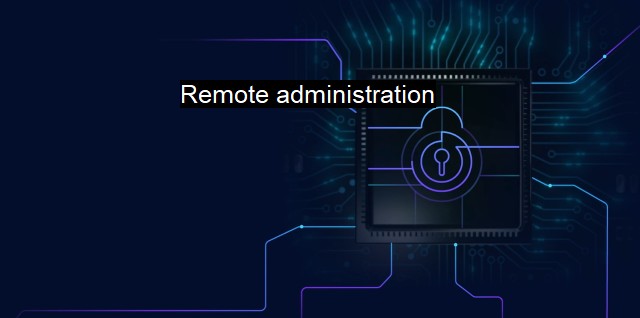What is Remote administration?
The Vital Role of Remote Administration in Cybersecurity and Antivirus Management: Achieving Flexibility and Protection from Anywhere
Remote administration refers to the process of remotely managing and monitoring computer systems from a central location. It enables administrators to perform all the necessary IT management tasks without being physically located in the same place as the systems being managed. Remote administration provides organizations with greater flexibility, allowing employees to work from anywhere and enabling IT departments to manage systems from any location.Remote administration plays a critical role in cybersecurity and antivirus management. With the increasing use of cloud computing and mobile devices for work, remote administration has become vital for cybersecurity and antivirus management in modern IT environments.
One of the key advantages of remote administration from a cybersecurity perspective is that it allows IT administrators to quickly identify and address security threats on remote systems. An IT administrator can remotely monitor and identify rogue devices connected to the corporate network, unauthorized software installs, or any suspicious activity on any device. With high-grade remote administration tools, IT administrators can even connect to remote endpoints, run customized antivirus scans, and perform system patches to protect corporate devices.
Antivirus management is another critical area of focus for remote administration. With remote administration tools, an IT manager can remotely ‘push’ a new antivirus signature or update, verify the status of antivirus signatures remotely, and get alerts & notifications on any critical issues like system infections or quarantine files.
Perhaps one of the most significant advantages of remote administration in antivirus management is when a virus outbreak is identified. Remote administration enables IT to react very quickly by performing antivirus scans across all remote endpoints. With real-time visibility of the status of remote devices that may be infected and coupled with good endpoint security technologies, remedial actions can be triggered remotely and managed centrally. Remote administration provides IT administrators with the ability to centrally stay-prepared and proactively address security challenges most appropriately.
the value proposition of remote administration stems from its ability to simplify IT management, and streamline IT tasks. With remote administration enabled IT administrators can manage and diagnose remote-endpoint scenarios and react at pace, which are facilitated through significantly improved end-to-end visibility and drive successful and timely resolution.
In cybersecurity and antivirus management contexts, the advantages of remote administration are clear and obvious – remote administration increases businesses’ productivity, efficiency, and quality of service. it’s paramount to ensure that remote administration tools have excellent access and system control protocols to prevent unauthorized access whilst providing auditable logs for investigation of suspicious access attempts. Similarly, providing end-as-much visibility and enacting a common-distributed security strategy providing endpoint-controlled settings for potentially higher identify value. All these enable cybersecurity and antivirus strategy looking to safer representation of workflows and ongoing remote assessments of system posture and resilience towards current and emerging threats.

Remote administration FAQs
What is remote administration?
Remote administration is the ability to manage and control a computer or network from a remote location, without being physically present. It allows an administrator to access and manage the resources of a computer or network from any location with an internet connection.Why is remote administration important in cybersecurity?
Remote administration is important in cybersecurity because it allows administrators to remotely monitor and manage security settings on their devices, which helps to ensure that they remain secure. It also allows administrators to perform updates and patches, as well as respond quickly to any security incidents that may occur.What are some of the risks associated with remote administration?
Remote administration can pose several risks to cybersecurity. These include the possibility of unauthorized access, malware attacks, and data breaches. Without proper security controls in place, remote administration can provide a backdoor for attackers to gain access to sensitive data or systems.What steps can be taken to secure remote administration?
There are several steps that can be taken to secure remote administration. These include using strong passwords, limiting access to authorized users only, using two-factor authentication, encrypting network traffic, and regularly monitoring logs for unusual activity. Additionally, it is important to keep software and security systems up to date and to maintain an incident response plan in case of a security breach.| | A | | | B | | | C | | | D | | | E | | | F | | | G | | | H | | | I | | | J | | | K | | | L | | | M | |
| | N | | | O | | | P | | | Q | | | R | | | S | | | T | | | U | | | V | | | W | | | X | | | Y | | | Z | |
| | 1 | | | 2 | | | 3 | | | 4 | | | 7 | | | 8 | | |||||||